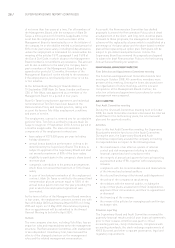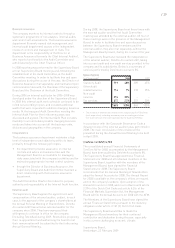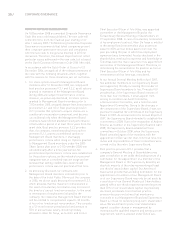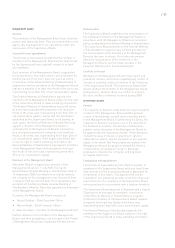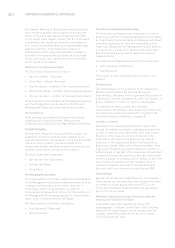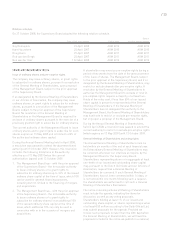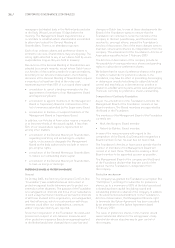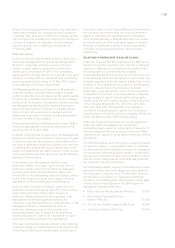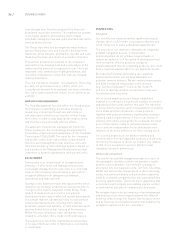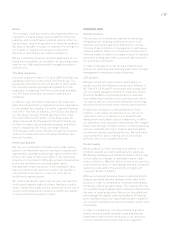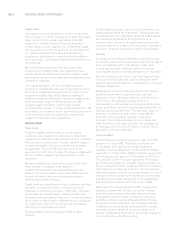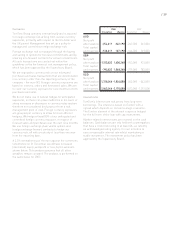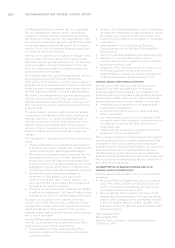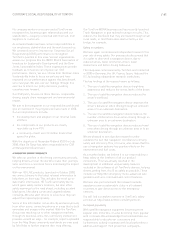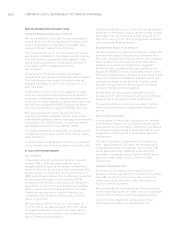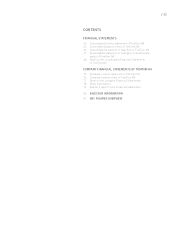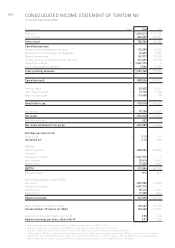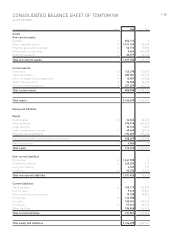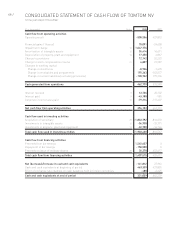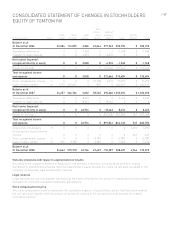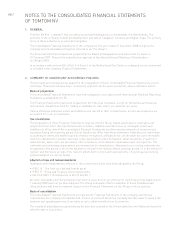TomTom 2008 Annual Report Download - page 40
Download and view the complete annual report
Please find page 40 of the 2008 TomTom annual report below. You can navigate through the pages in the report by either clicking on the pages listed below, or by using the keyword search tool below to find specific information within the annual report.38 / BUSINESS RISKS (CONTINUED)
Supply chain
Our supply chain and distribution model is outsourced.
This increases our ability to scale up or down the supply
chain, while limiting capital expenditure risks. We
depend on a limited number of third parties and in
certain instances sole suppliers, for component supply
and manufacturing. Any disruption to, or termination of
our relationships with third party manufacturers,
suppliers or distributors, or reduction in their ability to
meet our needs, could have a material adverse effect on
our business.
We continually evaluate the risks associated with
outsourcing our supply chain. Our engineering and
quality assurance departments perform regular audits
and ongoing reviews of our manufacturing partners and
component suppliers.
The supply disruption risk for our highest volume
products is mitigated by dual-sourcing production from
two different manufacturing partners. In order to limit
component supply risks, we perform de-risking of
hardware design by evaluating component supply at the
earliest possible stage of the design process. We
mitigate supply disruption risks through actively
minimising the number of single source components. We
have taken out insurance for our lost market opportunity
in the event that a natural catastrophe significantly
impairs our manufacturing capabilities.
FINANCIAL RISKS
Trade credit
Trade receivables relate mostly to our wholesale
customers. Our exposure to credit risk is influenced
mainly by the individual characteristics of each customer.
There is some concentration of credit risk with respect
to trade receivables, but this is actively monitored by
management. For our PND business, most of our
exposure to credit risk in Europe, US, Asia, Australia and
Africa is further mitigated by the purchase of credit
insurance.
We have established a credit policy under which each
new customer is analysed individually for
creditworthiness before our standard payment and
delivery terms and conditions are offered. We take into
account the view of external rating agencies when
determining creditworthiness.
Credit limits are established for each customer and then
reviewed on a quarterly basis, or more frequently if
required. In monitoring customer credit risk, customers
are grouped according to their credit characteristics.
Customers who are graded “high risk”, or who otherwise
fail to meet our benchmark creditworthiness, are placed
on a restricted customer list and we only do business
with these on a pre-payment basis.
Total bad debts currently represent 0.8% of sales
revenue.
Certain financial assets, such as trade receivables, are
individually assessed for impairment. When assets are
considered not to be individually impaired, these assets
are subsequently assessed for impairment on a
collective basis. Evidence of impairment could include
our past experience of debt collecting and/or changes in
economic conditions that have an effect on receivables.
Liquidity
Our approach to managing liquidity is to ensure, as far
as possible, that we will always have sufficient liquidity to
meet our liabilities when they fall due, under both
normal and stressed conditions, without incurring
unacceptable losses or risking damage to our reputation.
We consistently monitor future cash flow requirements
to ensure we have sufficient cash on demand to meet
expected operational expenses, including the servicing of
financial obligations.
Management monitors rolling forecasts of the Group’s
liquidity reserve which comprises cash and cash
equivalents (note 19) and an undrawn credit facility of
€175 million. An adequate liquidity position is
maintained via continuously monitoring forecasted and
actual cash flows, and matching the maturity profiles of
financial assets and liabilities. The potential impact of
extreme circumstances that cannot reasonably be
predicted, such as natural disasters, have been
excluded. The contractual maturity of our trade and
other liabilities is less than one year. Our outstanding
borrowings amount to €1,427 million, of which 10% is
due within 12 months (note 23).
Loan covenants
TomTom Group incurred an acquisition debt of €1,585
million on 10 June 2008. The facility terminates on
31 December 2012 and has an annual repayment
schedule. The first repayment, of 10% of the Principal,
was made on 31 December 2008 and further repayments
are scheduled, each year on 31 December, of 10%,15%,
15% and 50% of the Principal respectively. The Group’s
borrowings are subject to covenant clauses whereby the
Group is required to meet certain performance indicators
with regard to our financial condition. The performance
indicators relate to interest cover and leverage. In case of
a breach of these covenants the banks are contractually
entitled to request early repayment of the outstanding
amount (€1,427 million as at 31 December 2008).
Based upon the Group’s plans for 2009, management
expects to comply with the loan covenants. However,
given the uncertainties in the wider macro economic
environment and their knock on effect on consumer
spending, scenarios can be envisaged where the loan
covenants could be breached. The company continues
to evaluate options aimed at remaining within its loan
covenants under a variety of scenarios, which could
include renegotiating the terms of the facility in isolation
or in combination with other actions.


